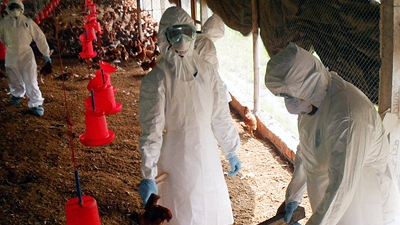There are many different strains of bird flu, but reports of a highly pathogenic strain of H5N1 have been largely concentrated in Asia. “Rapid response team kills 2,700 chickens” was the front page headlines in the Kathmandu Post, Feb 7th edition. The article goes on to highlight how chickens were slaughtered by the government response team following confirmation of an outbreak of highly pathogenic avian influenza H5N1 – better known as bird flu. Anxiety over risk of a global disease pandemic sparked by bird flu may have died down for the moment in many parts of the world, but Nepal remains on red alert. “Even if one crow dies that could contact poultry we will hear…. everyone in the country is aware and we can take quick action to contain and stampout because we are prepared” stated Dr. Rajawar, a senior Nepalese government official. “we respond as ONE in less than one week but so many are involved…from villager and farmer up to parliament."
A credit to this emergency response is the Nepal Avian Influenza Control Project (AICP) which is financed by the World Bank and engages with a number of national, regional and international partners from human health to wildlife and animal health sector including FAO, WHO, OIE and UNICEF. This ONE HEALTH approach acts locally but contributes to reducing the risk of a global disease pandemic potentially affecting every one. This ONE HEALTH approach to disease control has been so effective that the Government of Nepal wants to use it to control other infectious diseases. A Bank mission led by Norman Piccioni was in Nepal in February to help the government do just that; the new project – Nepal Zoonoses Project, will build on AICP to expand the this foundation to other infectious diseases.
Helping the country move from emergency response to preparedness saves lives and livelihoods. Effective surveillance and control means the disease is quickly and cost effectively contained to fewer poultry.This is important because poultry are an important livelihood and food security asset for the poor. Quick and accurate response increases the chance that fewer birds need to be slaughtered. In the early days of the campaign, hundreds of thousands of chickens were killed and as a preventative measure even those birds that were not infected with the flu, leading to massive loss of income.
Bird Flu – A Risk for a Human Disease Pandemic?
There are many different strains of bird flu but the largest number of reports of a highly pathogenic strain of H5N1 has been largely concentrated in Asia. This is highly contagious between chickens causing nearly 100% deaths. It is also transmitted to humans coming in direct contact with poultry and WHO data indicate over 60% of cases classified as H5N1 resulted in death. The risk of pandemic is that the highly pathogenic H5N1 mutates and becomes as lethal and as easily transmittable between humans as it is currently between birds. Influenza viruses have a high mutation rate. The World Bank project in Nepal has not only built capacity for preparedness to respond to bird flu, but also contributes to the ONE HEALTH of the world by reducing the pandemic risk.
The ONE HEALTH Approach:
The ONE HEALTH approach to disease control and prevention recognizes that the health of humans, animals and the ecosystem are interconnected and the best way to control diseases is a cross-sectoral, multidisciplinary and integrated multi-partner approach. For example, HPAI H5N1 ‘bird flu’ is transmitted from wild birds to domestic poultry which then transmit it to humans. While other diseases like Japanese Encephalitis is transmitted by mosquitos, livestock like pigs serve as a reservoir for the disease and from here the disease is transmitted by mosquitos to human causing high mortality rates.

